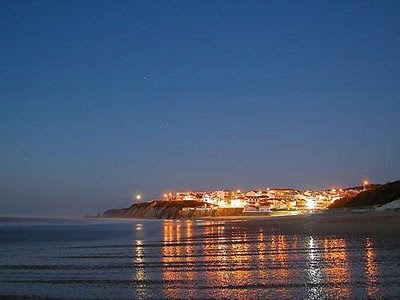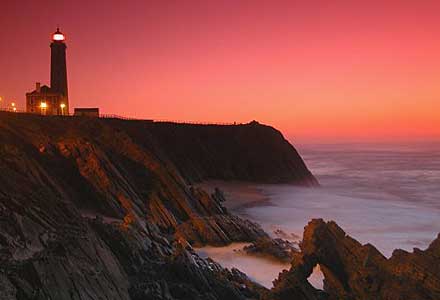
Alburitel origins
This village origins are as old as the Arab occupation, one thousand years ago.
Its located in the higher hill in the way from Santarém to Coimbra (Conimbriga) two of the most important roman cities in the time.
A safe spot to stop during the commercial travel in the peninsula.
Is name was awarded by is gretest name, the Duque Alvaro Teles, first
lord of the castle of Ourém.
Around there is a chapel from dated from 1592, and the castle of Ourem conquered from the Arabs
during the raise of the nation.
Arround Alburitel - Points of interest

Tomar was raised by the “Order of the Templars” during the Crusades.
Now is a small and quiet town with a University, river gardens and,
in the shadow of is large fortified medieval castle, and the Convent.
The Gotic Convent is a wold heritage because of is architecture.
Crossed by the river NABÃO, and with several small island full of gardens and pubs and family restaurants.
For further info:
Municipality of Tomar |
UNESCO - Convent of Christ in Tomar

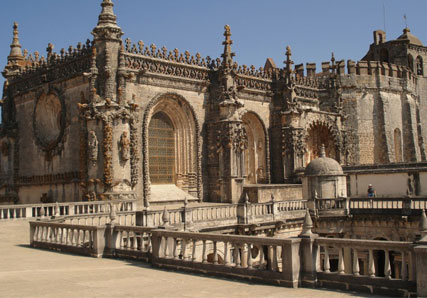
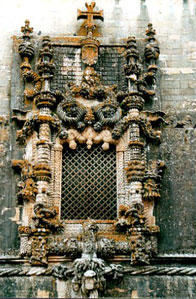
Near Tomar there is another beautiful place that deserves a visit. Its the Almourol Castle, that was erected in a small island in the middle of the Tejo River.
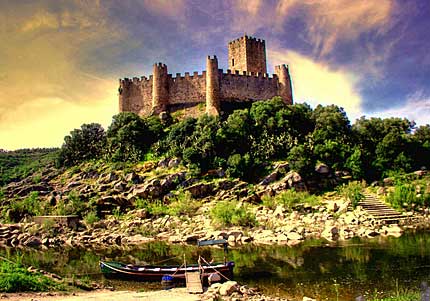
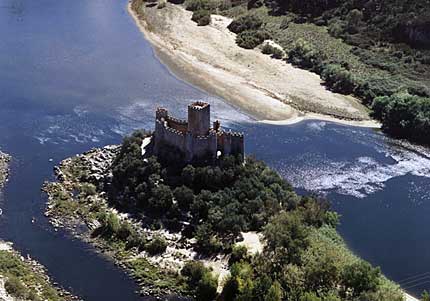
For further info visit: Almourol Castle (source:Wikipedia)

On 13 May 1917, three children were pasturing their little flock in the Cova da Iria, parish of Fatima, town of
Vila Nova de Ourém. today the diocese of Leiria-Fatima. They were called: Lucia de Jesus, aged 10,
and her cousins Francisco and Jacinta Marto, aged 9 and 7.
About midday, after praying the Rosary, as was their custom, they were amusing themselves building a little house
of stones scattered around he place where the Basilica now stands. Suddenly they saw a brilliant light, and thinking it
to be lightning, they decided to go home. But as they went down the slope another flash lit up the place,
and they saw on the top of a holmoak (where the Chapel of Apparitions now stands),
"a Lady more brilliant than the sun", from whose hands hung a white rosary.
The Lady told the three little shepherds that it was necessary to pray much, and she invited them to return to the
Cova da Iria during five consecutive months, on the 13th day at that hour. The children did so and the 13th day of June,
July, September and October, the Lady appeared to them again and spoke to them in the Cova da Iria.
On the 19th of August, the apparition took place at Valinhos, about 500 meters from Aljustrel, because on the
13th the children had been carried off by the local Administrator to Vila Nova de Ourém.
At the last apparition, on October 13, with about 70,000 people present, the Lady said to them that she was the
"Lady of the Rosary" and that a chapel was to be built there in her honor. After the apparition all present witnessed
the miracle promised to the three children in July and September :the sun, resembling a silver disc, could be gazed at
without difficulty and, whirling on itself like a wheel of fire, it seemed about to fall upon the earth.
Afterwards, when Lucia was a Religious Sister of Saint Dorothy, Our Lady appeared to her again in Spain
(10 December 1925 and 15 February 1926, in the Convent of Pontevedra, and on the night of 13/14 June 1929,
in the Convent of Tuy), requesting the devotion of the five first Saturdays (to pray the Rosary, meditate on the mysteries
of the Rosary, confess and receive Holy Communion, in reparation for the sins committed against the Immaculate Heart
of Mary), and the Consecration of Russia to the same Immaculate Heart, This request had been announced by the
Apparition on 13 July 1917, in what is called the "Secret of Fatima".
Years later, Sr. Lucia related that, between April and October of 1916, an Angel had appeared to the three seers on three
occasions, twice in the Cabeço and once at the well in the garden behind Lucia´s house, who exhorted them to prayer
and penance.
Since 1917 pilgrims have not ceased to come to the Cova da Iria in thousands upon thousands from all parts of the
world, at first on the 13th of each month. later during the summer and winter holidays, and now more and more at
weekends and any day all the year round.
For further info:
Municipality of Ourém |
Fátima Sanctuary

The Monastery of the Dominicans of Batalha was built to commemorate the victory of the Portuguese over the Castilians
at the battle of Aljubarrota in 1385. It was to be the Portuguese monarchy's main building project for the next two centuries.
Here a highly original, national Gothic style evolved, profoundly influenced by Manueline art, as demonstrated by its masterpiece, the Royal Cloister.
Constructed in fulfilment of a vow by King João to commemorate the victory over the Castilians at Aljubarrota (15 August 1385),
the Dominican monastery of Batalha is one of the great masterpieces of Gothic art. The majority of the monumental complex dates
from the reign of João I, when the church (finished in 1416), the royal cloister, the chapter-house, and the funeral chapel of the founder were constructed.
Following a brief interruption, work was begun again under King Duarte on the prolongation of the choir, the construction of his funerary
chapel and that of his descendants, a spacious edifice based an octagonal plan that the death of the king in 1438 left unfinished.
The design has been attributed to the English architect Master Huguet. The chapel's floor plan consists of an octagonal space inserted inside a square,
creating two separate volumes that combine most harmoniously. The ceiling consists of an eight-point star-shaped lantern.
The most dramatic feature is to be found in the centre of the chapel: the enormous medieval tomb of Dom João I and his wife, Queen Philippa of Lancaster,
the first tomb for husband and wife made in Portugal, on which are carved the coats of arms of the Houses of Avis and Lancaster. Bays in the chapel walls contain the tombs
of their sons, among them Prince Henry the Navigator.
The main entrance of the church is through the porch on the west facade. On both sides of this portal are sculptures of the twelve apostles standing on consoles.
In the centre is a high relief statue of Christ in Majesty surrounded by the Evangelists, framed by six covings decorated with sculptures
of biblical kings and queens, prophets and angels holding musical instruments from the Middle Ages.
This great profusion of sculptures is completed by the crowning of the Virgin Mary.
The church's interior refers back to the period of sober Gothic majesty that has remained undisturbed by later additions.
The nave and aisles are separated by thick pillars crowned by capitals with plant motifs. The chancel windows, decorated with beautiful 16th century
stained-glass windows representing the Visitation, the Adoration of the Magi, the Flight into Egypt and the Resurrection of Jesus Christ,
project a diffused light that gives the church a feeling of great spirituality.
The last great period of Batalha coincided with the reign of Manuel I, who built the monumental vestibule and the principal portal, a
nd restored the royal cloister, built in the reign of Dom João I. The arches overlooking the garden were built later and are embellished
with finely carved tracery displaying the emblems of Dom Manuel I, the Cross of the Order of Christ and the armillary sphere. In the galleries
are doors leading to the various rooms of the former monastery, beginning with the large Chapter House, a marvellous example of the pointed arches
of Gothic architecture, in which the enormous vaulted ceiling has no central supports.
As a monument charged with a symbolic value from its foundation, the convent of Batalha was, for more than two centuries, the great workshop of the Portuguese monarchy.
It is not surprising that the roost characteristic features of a national art would have been determined there, during both the Gothic and the Renaissance periods.
Batalha is the conservatory of several privileged expressions of Portuguese art: the sober and audacious architectural style of the end of the 14th century,
with the stupendous nave of the abbatial, of which the two-storey elevation, whit broad arcades and high windows, renders more impressive its dimensions;
the exuberant aesthetic of the capelas imperfeitas; the marvellous flamboyant arcades embroidered in a lace-work of stone: the Manueline Baroque even more
perceptible in the openwork decor of the tracery of the arcades of the royal cloister than on the immense portal attributed to Mateus Fernandes the Elder;
and finally, the hybrid style of João de Castilho, architect of the loggia constructed under João III.
For further info:
Monastery of Batalha |
Batalha Municipality |
Fundação Batalha de Aljubarrota

Once the wedding present of a queen, the preserved medieval town of Óbidos lying 100 km north of Lisbon is without doubt
one of Portugal's most classic walled settlements. Walking the ramparts, visitors can enjoy views of windmills, vineyards and surrounding farmlands.
In the residential area below, narrow cobblestone streets are lined with whitewashed houses sporting terracotta roofs.
The shops are piled high with local handicrafts, while in spring the town is ablaze with geraniums, morning glories and bougainvillaea.
For further info:
Óbidos Municipality

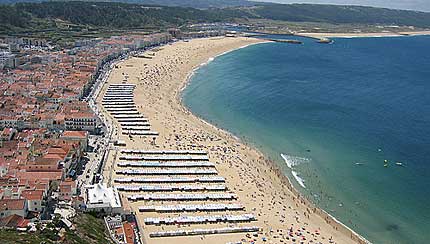 Possibly the most famous fishing town in Portugal, Nazaré is unique in many ways.
It doesn’t contain the architectural treasures or grandiose monuments prevalent in other Portuguese towns,
but it has an atmosphere of times gone by, contentment and traditions which continue to thrive, which make it a special place to visit
The wooden fishing boats still used today are colourful and narrow with curved prows and decoration
evocative of the first fishermen of the area; the Phoenicians, who settled here in pre-Christian times.
On some prows you’ll even still see a watchful eye painted – in theory to detect the two most important
things to a fisherman; shoals and storms – and many dangle lamps for fishing after sunset.
Possibly the most famous fishing town in Portugal, Nazaré is unique in many ways.
It doesn’t contain the architectural treasures or grandiose monuments prevalent in other Portuguese towns,
but it has an atmosphere of times gone by, contentment and traditions which continue to thrive, which make it a special place to visit
The wooden fishing boats still used today are colourful and narrow with curved prows and decoration
evocative of the first fishermen of the area; the Phoenicians, who settled here in pre-Christian times.
On some prows you’ll even still see a watchful eye painted – in theory to detect the two most important
things to a fisherman; shoals and storms – and many dangle lamps for fishing after sunset.
The Casa Museu do Pescador (R. Sousa Lobo) is a small museum dedicated to the fishing population of Nazaré.
Contained within a traditional cottage, it has been lovingly restored to show the exterior and interior of the home of a typical fishing family for the early part of the 20th century.
For further info:
Nazaré Municipality

São Pedro de Moel is a beach community near to the city of Marinha Grande in the district of Leiria, Portugal.
It is located within the Pinhal de Leiria, south of the mouth of Ribeira de Moel. It is a seaside village,
west of the cities of Marinha Grande and Leiria. In 1463 Don Afonso V gave São Pedro de Moel to the Count of Vila Real.
The family had a palace in Leiria and several houses in São Pedro de Moel. They lived on this beach until 1641, when the last
Marquis of Vila Real and Duke of Caminha were executed. The widowed Duquesa de Caminha, mourned the death of her
husband on a huge rock overlooking the beach that is named after him - Penedo da Saudade, at the top of which is a lighthouse with the same name.
The legend of the Duquesa de Caminha also claims that the rock the still resonates with her lament.
Overlooking the beach is the home of the poet Afonso Lopes Vieira which includes a chapel overlooking the ocean and a sun-clock.
The house was donated by the poet to the City of Marinha Grande for use as a resort for local children. Nowadays it is also used as a museum.
In the nineteenth century São Pedro de Moel was the location of a thriving resin factory, using the resources of the abundant local pine forests.
The entire beach was originally part of the Portuguese 'Matas Nacionais', but in 1923 was reorganised into to the Marinha Grande Municipality.
It is denoted by a central statue of King Dinis and Queen Santa Isabel.
Points of interest include the Praia Velha, Praia da Concha, Penedo da Saudade, the lighthouse and Ribeira de Moel, all slightly to the north.
In the pine forests there are several parks, and it includes the Round of Seven, which is a beautiful journey of approximately 7km, via sea, beach, pine forest, parks, fountains and streams.
(in wikipedia)
The is you can find too nice family restaurants and a big disco over the sea, the pool and the beach.
For further info:
Marinha Grande Municipality









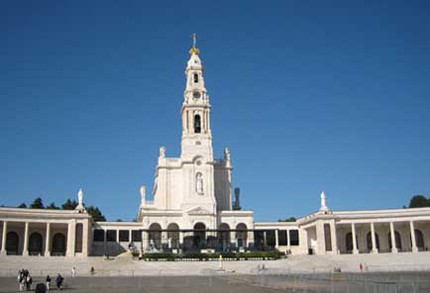
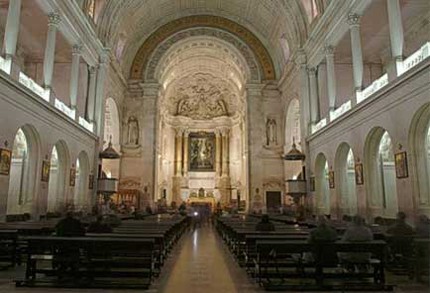




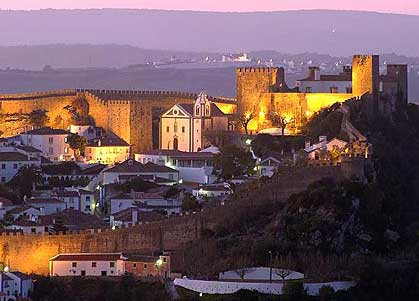


 Possibly the most famous fishing town in Portugal, Nazaré is unique in many ways.
It doesn’t contain the architectural treasures or grandiose monuments prevalent in other Portuguese towns,
but it has an atmosphere of times gone by, contentment and traditions which continue to thrive, which make it a special place to visit
The wooden fishing boats still used today are colourful and narrow with curved prows and decoration
evocative of the first fishermen of the area; the Phoenicians, who settled here in pre-Christian times.
On some prows you’ll even still see a watchful eye painted – in theory to detect the two most important
things to a fisherman; shoals and storms – and many dangle lamps for fishing after sunset.
Possibly the most famous fishing town in Portugal, Nazaré is unique in many ways.
It doesn’t contain the architectural treasures or grandiose monuments prevalent in other Portuguese towns,
but it has an atmosphere of times gone by, contentment and traditions which continue to thrive, which make it a special place to visit
The wooden fishing boats still used today are colourful and narrow with curved prows and decoration
evocative of the first fishermen of the area; the Phoenicians, who settled here in pre-Christian times.
On some prows you’ll even still see a watchful eye painted – in theory to detect the two most important
things to a fisherman; shoals and storms – and many dangle lamps for fishing after sunset.

